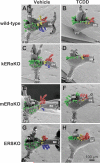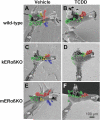Estrogen signaling is not required for prostatic bud patterning or for its disruption by 2,3,7,8-tetrachlorodibenzo-p-dioxin
- PMID: 19523480
- PMCID: PMC2766843
- DOI: 10.1016/j.taap.2009.06.001
Estrogen signaling is not required for prostatic bud patterning or for its disruption by 2,3,7,8-tetrachlorodibenzo-p-dioxin
Abstract
Estrogens play an important role in prostatic development, health, and disease. While estrogen signaling is essential for normal postnatal prostate development, little is known about its prenatal role in control animals. We tested the hypothesis that estrogen signaling is needed for normal male prostatic bud patterning. Budding patterns were examined by scanning electron microscopy of urogenital sinus epithelium from wild-type mice, mice lacking estrogen receptor (ER)alpha, ERbeta, or both, and wild-type mice exposed to the antiestrogen ICI 182,780. Budding phenotypes did not detectably differ among any of these groups, strongly suggesting that estrogen signaling is not needed to establish the prototypical prostatic budding pattern seen in control males. This finding contributes to our understanding of the effects of low-level estrogen exposure on early prostate development. In utero exposure to 2,3,7,8-tetrachlorodibenzo-p-dioxin (TCDD) can greatly alter the pattern in which prostatic buds form and reduce their number. For several reasons, including a prior observation that inhibitory effects of TCDD on prostatic budding in rats depend heavily on the sex of adjacent fetuses, we tested the hypothesis that estrogen signaling is needed for TCDD to disrupt prostatic budding. However, budding did not detectably differ among wild-type mice, or mice lacking ERalpha, ERbeta, or both, that were exposed prenatally to TCDD (5 microg/kg on embryonic day 13.5). Nor did ICI 182,780 detectably affect the response to TCDD. These results strongly suggest that estrogen signaling is not needed for TCDD to inhibit prostatic epithelial budding.
Figures



References
-
- Abbott BD, Lin TM, Rasmussen NT, Albrecht RM, Schmid JE, Peterson RE. Lack of expression of EGF and TGF-α in the fetal mouse alters formation of prostatic epithelial buds and influences the response to TCDD. Toxicol. Sci. 2003;76:427–436. - PubMed
-
- Benedict JC, Lin T-M, Loeffler IK, Peterson RE, Flaws JA. Physiological role of the aryl hydrocarbon receptor in mouse ovary development. Toxicol. Sci. 2000;56:382–388. - PubMed
-
- Bookstaff RC, Moore RW, Peterson RE. 2,3,7,8-tetrachlorodibenzo-p-dioxin increases the potency of androgens and estrogens as feedback inhibitors of luteinizing hormone secretion in male rats. Toxicol. Appl. Pharmacol. 1990;104:212–224. - PubMed
Publication types
MeSH terms
Substances
Grants and funding
LinkOut - more resources
Full Text Sources
Medical

